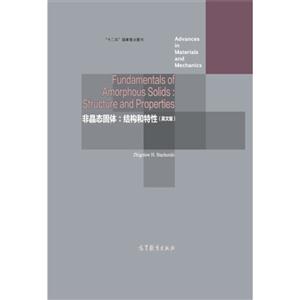-
>
中国古代建筑概说
-
>
世界古建筑之谜
-
>
如何理解建筑
-
>
中国的建筑与景观
-
>
营造法式
-
>
美国建筑设计的领跑者:麦金、米德与怀特事务所专辑
-
>
百年城市规划史:让都市回归都市
非晶态固体:结构和特性-(英文版) 版权信息
- ISBN:9787040426298
- 条形码:9787040426298 ; 978-7-04-042629-8
- 装帧:一般胶版纸
- 册数:暂无
- 重量:暂无
- 所属分类:>>
非晶态固体:结构和特性-(英文版) 本书特色
本书采用独特的方法阐述了非晶态固体的基础理论。将非晶态固体分为无机玻璃、有机玻璃、玻璃金属合金和薄膜四类,构建了非晶态固体的结构模型,定义了理想的非晶体固体的原子排列,澄清了玻璃固体中非晶态原子排列的奥秘。 本书是学习路径积分的一本经典著作,不仅可供物理系师生使用,也是专业人员极好的参考资料。
非晶态固体:结构和特性-(英文版) 内容简介
本书采用独特的方法阐述了非晶态固体的基础理论。将非晶态固体分为无机玻璃、有机玻璃、玻璃金属合金和薄膜四类,构建了非晶态固体的结构模型,定义了理想的非晶体固体的原子排列,澄清了玻璃固体中非晶态原子排列的奥秘。
非晶态固体:结构和特性-(英文版) 目录
非晶态固体:结构和特性-(英文版) 作者简介
Zbigniew H. Stachurski,澳大利亚国立大学教授。1965年本科毕业于波兰 AGH 科技大学( Krakow),1968年博士毕业于英国Bristol大学。1991年当选澳大利亚皇家化学学会会员,1993年获皇家化学学会“聚合物材料突出贡献奖”。2002年任澳大利亚国立大学材料中心主任。为英国、瑞士、希腊、新加坡等多所高校的访问教授。会讲5种语言:English, Polish, Ukrainian, French, Russian.
- >
大红狗在马戏团-大红狗克里弗-助人
大红狗在马戏团-大红狗克里弗-助人
¥3.9¥10.0 - >
小考拉的故事-套装共3册
小考拉的故事-套装共3册
¥36.7¥68.0 - >
苦雨斋序跋文-周作人自编集
苦雨斋序跋文-周作人自编集
¥6.9¥16.0 - >
回忆爱玛侬
回忆爱玛侬
¥12.5¥32.8 - >
诗经-先民的歌唱
诗经-先民的歌唱
¥15.1¥39.8 - >
李白与唐代文化
李白与唐代文化
¥9.9¥29.8 - >
山海经
山海经
¥19.2¥68.0 - >
二体千字文
二体千字文
¥16.0¥40.0
-
2022图书×抽奖盲袋
¥9.9¥25 -
2023读书月阅读盲盒——天黑,闭眼,刀谁?
¥42.3¥158 -
2022读者节纪念徽章-三星会员专属
¥45¥45.6 -
2023读书月阅读盲盒——我什么场面没见过?
¥42.3¥158 -
2023读书月阅读盲盒——去码头整点什么薯条?
¥42.3¥158















